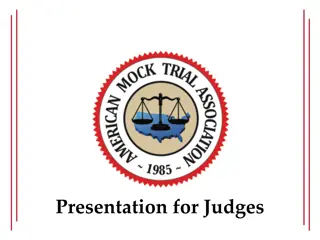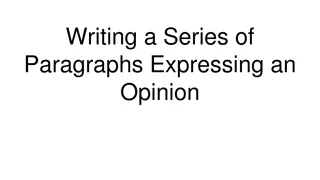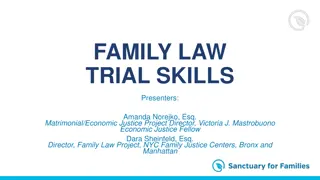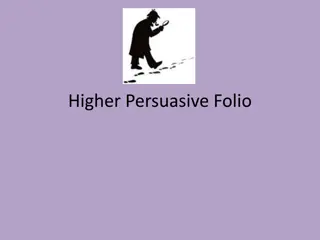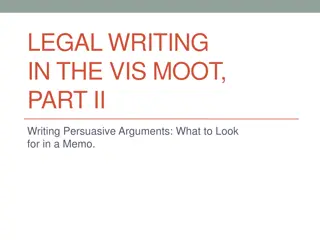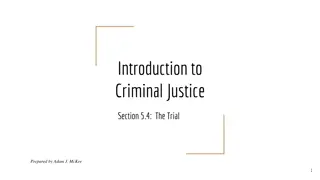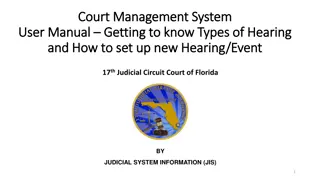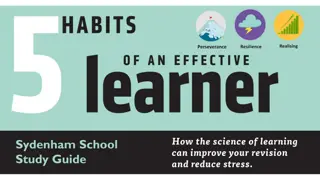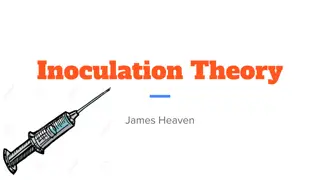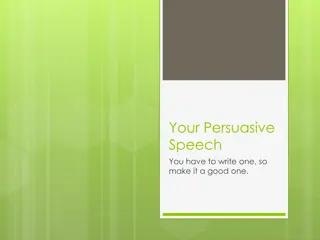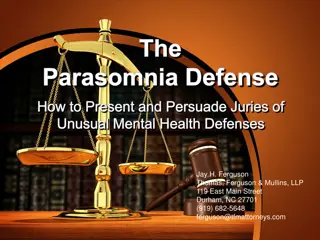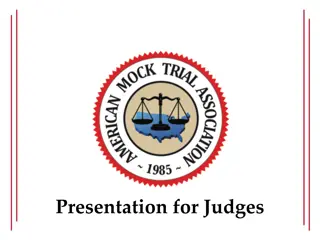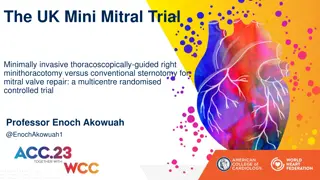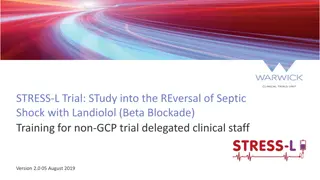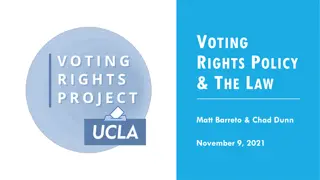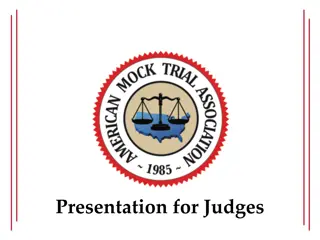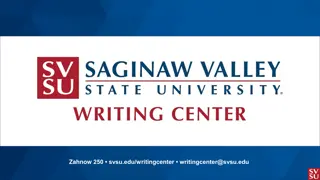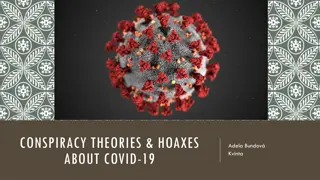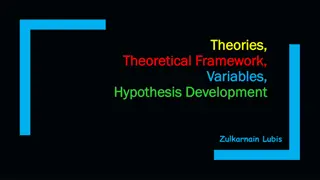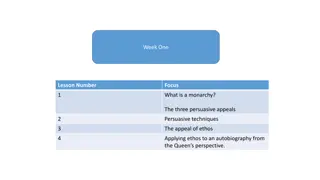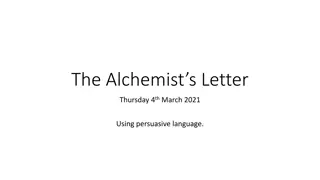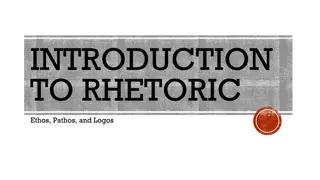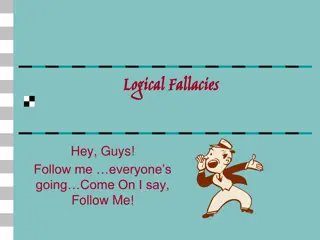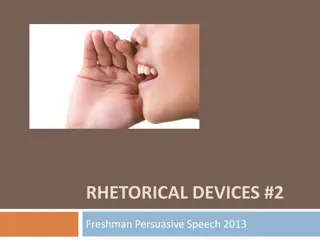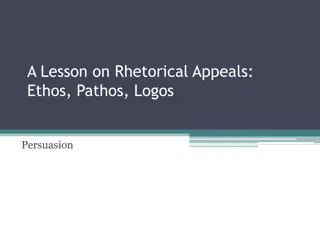Crafting Persuasive Defense Theories for Trial Success
Explore the art and science of cross-examination, theory development, and defense strategies in trial storytelling. Learn the essential components of a compelling defense theory, emphasizing factual, legal, and emotional aspects. Discover examples illustrating effective defense strategies for presenting a convincing case in court.
Download Presentation

Please find below an Image/Link to download the presentation.
The content on the website is provided AS IS for your information and personal use only. It may not be sold, licensed, or shared on other websites without obtaining consent from the author. Download presentation by click this link. If you encounter any issues during the download, it is possible that the publisher has removed the file from their server.
E N D
Presentation Transcript
LIGHTS, CAMERA, ACTION! TELLING YOUR TRIAL STORY THROUGH CROSS- EXAMINATION
ITS STORYTIME This Photo by Unknown Author is licensed under CC BY-NC-ND This Photo by Unknown Author is licensed under CC BY-SA-NC
CROSS-EXAMINATION: ART OR SCIENCE? Referring to cross-examination as an art conveys the erroneous message that some trial lawyers have the talent to cross-examine while others don t. It assumes cross-examination has no rules or fixed reference points. It cannot be taught or learned, but only viewed in wonderment and awe. --Cross-Examination: Science and Techniques, Pozner & Dodd
WRITING THE SCRIPT: DEVELOPING A THEORY What is a defense theory? A persuasive statement that justifies the verdict you are seeking. Your theory is the structure around which the story you tell will be developed. The case theory gives your story shape. It provides the theme, sets out the characters, and provides the emotion necessary to move the jury.
A DEFENSE THEORY IS NOT A LEGAL DEFENSE The Government will not be able to prove BRD that my client is guilty. The complainant misidentified my client. Client acted in self-defense. That s your legal defense. The defense tells us something about the legal rationale as to why a client is not guilty. It gives us a very general idea as to why a client isn t guilty. But it says nothing about the tactical decision we will make in order to get to not guilty.
EXAMPLES OF DEFENSE THEORIES The snitch was looking at a 25-year mandatory sentence so he made up a story about the client confession. Decedent, who was 6 4 and a former offense lineman, kept coming and pushing the fight, forcing poor, frail client who was 5 6 and a 125 lbs to shoot in order to save his own life. Sgt. Robinson was under pressure to quickly solve this case so she cut corners in her investigation and ignored other leads.
THREE COMPONENTS OF A GOOD THEORY Factual Component Legal Component Emotional Component
FACTUAL COMPONENT: FACTS BEYOND CHANGE (FBC) FBC: FBC s are facts that will be believed by the jury as fair, accurate, and highly relevant regardless of best efforts to dispute or modify them. Any good theory must either incorporate all facts beyond change, or be neutral to them. That is, a theory must either build upon the FBC, or stand in harmony with them. A successful theory of the case can never contradict a FBC, because, if the fact finder is confronted with a theory and an actuality (an FBC), and the two cannot exist simultaneously, the fact finder must decide the case in accordance with the actuality (the fbc).
EXAMPLES OF FBC Complainant was shot four times in the back Client s BAC was 3x the legal limit Witness entered into a cooperation agreement Weather Lighting Stolen property in client s possession Drug results
FACTS BEYOND CHANGE: DONT STOP WITH THE NEGATIVE Example: A search of Kristin Lavoy s suitcase while at DTW yields 2 kilos of cocaine and a bag of Oxy pills . The issue is whether Ms. Lavoy consented to a search of her suitcase. Assume the following facts beyond change: When she was initially stopped she protested She refused to signa a Miranda form Officers never advised of her right to leave w/o being searched She pulled her suitcase towards her Four DEA agents surrounded her Agents were armed and uniformed At no time did she manifest an attitude of cooperation.
WHY CROSS EXAMINE? TO ADVANCE THEORY/STORY OF THE CASE! THAT S IT. Highlighting helpful facts. Putting harmful facts in context Attacking witness credibility. Mistaken Lying Bias Unreliable Combination DO NOT REPEAT THE DIRECT!!
WHY CROSS-EXAMINE? NO QUESTIONS, JUDGE Does this witness help you advance your theory of the case? Saying no questions sends a message to the jury that the witness means nothing to you and didn t say or do anything to hurt your client s case.
THEORY FOR THE WITNESS What do you want FF to believe about this witness This witness is bias This witness was sloppy in her investigation This witness is mistaken This witness is lying
MAKE CHAPTERS FOR EACH WITNESS One discrete point that supports your theory of the case and theory of the witness Theory: Gov t witness lying on your client to avoid prison sentence Sammy Snitch Chapters: Reason to doubt Sammy Snitch testimony because he has snitched in the past and received a benefit; Reason to doubt Sammy Snitch s testimony because he was facing 25 mandatory years before making deal with government; Reason to Doubt Sammy Snitch s testimony because he told a completely different story before he was given the plea deal
ONE CHAPTER PER PAGE Easier to reorganize, add, or delete chapters mid-trial Easy to reference mid-cross Leads to less reliance on notes
ARRANGE THE ORDER OF YOUR CHAPTERS Primacy and Recency Use Safe, strong points after risky, weaker ones Use order of chapters to tell your story of the witness.
WRITE OUT QUESTIONS FOR EACH CHAPTER 1st Responder to crime scene important First responder First responder has responsibilities Securing crime scene Secure crime scene to make sure nothing contaminates it Make sure ppl don t walk through it Collect evidence Gloves
SOURCE YOUR FACTS Source all of your facts Had been drinking (Carter, Supp Rpt, Pg 3) Heard 5 shots (Griggs, Search Warrant Affidavit, pg 4) Decedent 5 shots to back (Med. Exam Report pg 4)
MAKING STATEMENTS(ASKING QUESTIONS) LEAD LEAD LEAD LEAD LEAD Leading questions DECLARE the answer: Officer, you were not wearing gloves when you handled the evidence. Leading Questions allow you to control word choice Leading Questions trains the witness to give short answers Never begin a cross question with who, what, when, why, how, explain, or describe: Encourages long winded answers and introduces far greater dimensions of risk and occasions for less control
MAKING STATEMENTS (ASKING QUESTIONS) SHORT QUESTIONS/INCH TOWARD GOAL SAMMY SNITCH: Desperate to avoid prison sentence You were in jail You didn t want to be there Just got out of prison Just got home to family You were facing at least 25 years mandatory time Gov t Strong case against you Caught you red handed
PREPARING STATEMENTS (QUESTIONS) ONE FACT PER QUESTION Gives more control over a witness Helps jurors to process and digest information better When a witness response yes or no, easy to figure out what he/she is saying. E.g. Officer, you were the first on the scene Three wittiness outside Shell casings Dead body Yellow tape etc.
FOCUS ON OBJECTIVE FACTS/STAY AWAY FROM CONCLUSIONS Try to use objective fact in your questions Don t ask questions that call for subjective opinions or ultimate conclusions It was too dark to see his face You were under a lot of pressure to solve this case You were desperate to avoid jail.
EXCEPTION TO THE RULE Stay away from the subjective UNLESS you absolutely, positively, unequivocally have the goods on a witness. If the facts you have point to the only subjective standard that would be logically permissible or plausible. Hand to Hand: You really didn t get a good look at the person s face who shook hands with Michael It was pitch black outside (GJ, pp 5 lines 12-13) The street lights were broken (Id) You were half a block away )Id_ Individual had a hoodie was wearing a mask
QUESTIONS: NO WASTED WORDS No wasted words As a rule, don t use crutches at the beginning or end of your sentence E.g., - Prior to handing Det. Greggs the heroin, you can t tell us whether Det. Gregg searched you, isn't that right? E.g. isn t it true you can t tell us whether Det Griggs searched you prior to you handing her the heroin. EXCEPTION: TO UNDERSCORE A PARTICULAR PONIT E.g. setting up an impeachment It s fair to say, you don t know whether Det. Greggs searched you prior to you handing her the heroin.
QUESTIONS: IMPEACHMENT Impeachment Most common form is impeachment via prior inconsistent statement Impeachment via omission Other forms of impeachment Inconsistency with another witness Bias covered on a later date Prior conviction
QUESTIONS: IMPEACHMENT Impeachment via PIS Three Cs Commit the witness to the direct testimony Confront the witness with the inconsistent stmt Complete the impeachment
QUESTIONS: IMPEACHMENT Impeachment via PIS COMMIT E.G. you have an affidavit in support of a search warrant authored by Det. Johnson saying, Det. Griggs searched CI410 prior to CI410 entering the residence Det. Johnson, on direct, claims HE searched CI 410. Use language signaling an impeachment is coming E.g. today, you re claiming you searched CI 410 prior to CI410 entering the alley
QUESTIONS: IMPEACHMENT Confront (Prior version is true) You want to credit the prior version Build the prior version up E.g., you have a police report where eyewitness describes robbery suspect as 5 9, light skinned, with curly hair. Direct: 6 , dark skinned, short hair. (Matches client s description) Neither version is true Nearly the same foundation However, do not build up the indicia of truth
QUESTIONS: IMPEACHMENT COMPLETE If impeachment via prior inconsistent statement you read the statement word for word If impeachment via another w, ask the w the question you plan to ask the impeachment w (don t forget to call the witness) If impeachment via omission, there are different ways: You never said (omitted fact) Read (document) and look up when you find the spot where you said (Omitted fact) I m going to give you this red pen, circle where you said it.
QUESTIONS: IMPEACHMENT VIA OMISSION Practically, you ll likely be using a grand jury transcript or a police report. Must establish: The w understood the need to be complete on important details The document, report, hearing, or interview must have been an (hopefully, the ) appropriate place to speak of or note the important matter that was omitted At the time of the interview (hearing, report, etc.), the w knew or should have known of the important matter that was omitted. You must establish: A question was asked that would have elicited a response including the omitted matter.
OVERALL TECHIQUES:GENERAL TO SPECIFIC This rule governs the overall organization of the cross. Before questioning an officer on the specifics of what s missing in her report, you begin by establishing the general principles of report writing. Before highlighting an officer s failure to properly preserve a crime scene, begin by establishing why it s important to preserve a crime scene
OVERALL TECHNIQUES Use Transitions to get the witness focused, to let FF know what you are going to talk about, to get a quick yes, and to cut down on exits. It helps to narrow the discussion, secures the witnesses agreement, and gets a free yes. Use TRILOGIES: Helps drive home themes: facts have changed Use Plain Language
DURING EXAMINATION Listen to the answers Be aware of your volume and pace Get your answer Be professional no matter how unprofessional the witness is
RULES TO LIVE BY Don t beat the witness up unless the jury gives you permission Be careful of the one question to many, usually begins with So Never ask a question you don t already know the answer to Have a road map and make it clear to the jury Style. Some attys write out every question. Some only write an outline and wing it from there. Whatever your approach, just know where you want to go. Be careful with notes. Don t be wedded to them. Be willing to deviate. I ve seen lawyers get into chapters that prosecutors forgot. Don t call him a liar Never quibble over small points unless you have to Short questions


